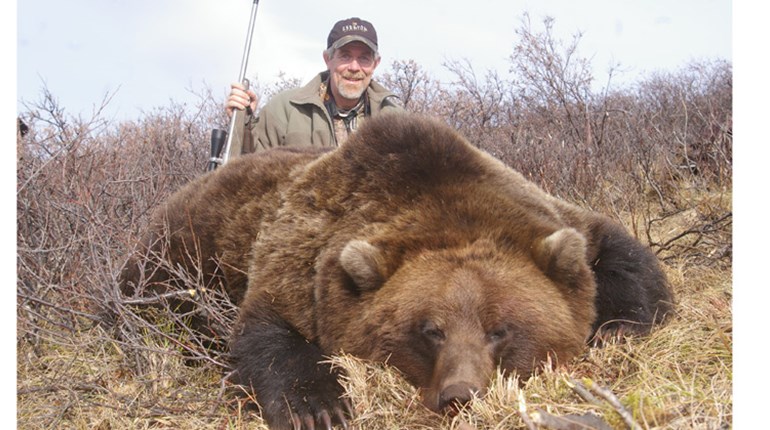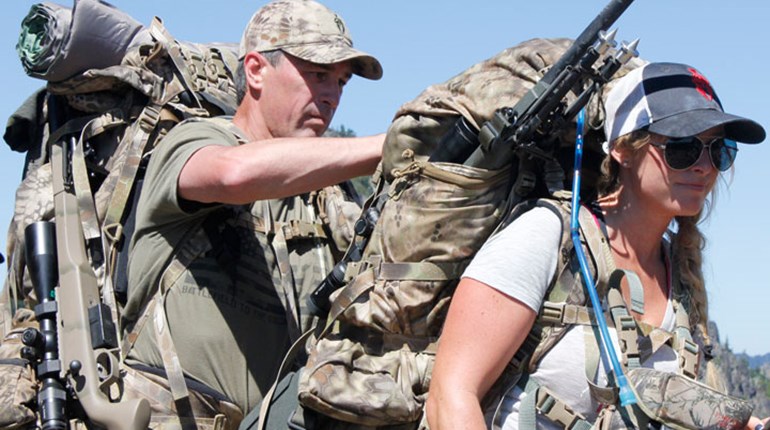
I was hoping for a ruffed grouse when my setter pointed a big covey of gray partridges, which led, naturally enough, to a 6x7 bull elk. You don’t believe me? Well, let me explain.
I was bird hunting in north Idaho in late September, about a week before the firearm elk season opened, hoping to put blue grouse, ruffed grouse or gray partridge in the bag. The setter and I were working the edges of rolling wheat fields where they spilled suddenly into deep, relatively narrow canyons bleeding down from the conifer-clad mountains about 5 miles to the north. The partridge lived along the wheat field edges. The grouse lived in the forested canyons, but they often foraged in isolated hawthorns and elderberries growing near the top. The edge was the place to be.
Sota pointed a thrilling covey of Huns, but when she disappeared over the edge to fetch one, she didn’t come back. So I started whistling. An elk bugled back.
You can imagine what the pure, high-country scream of a bull elk did to enliven my bird hunt! Well, it actually shut it down. Right quick. No way was I going to harass that elk with gunshots. And certainly not by stomping through his hiding spot with a dog. I sat tight and kept whistling until young Sota relocated me. I took the Hun from her and we backed out of there, hoping no other bird hunters would discover what we had.
They didn’t. On the elk opener, Sota stayed in the kennel and I hiked into the canyon for some one-on-one with that bull. Turned out he had a bunch of friends, but all I saw of them were legs flickering under pine and fir boughs as the herd streamed and screamed from its upper canyon feeding grounds to a dark stand of old growth. My chances for spooking them in there were better than my chances for shooting one, so I backtracked the herd, found where it had been feeding and watering, and banked on habit to earn a shot the next day.
The following morning I arrived before the elk, got between their feeding and bedding sites and caught that 6x7 bull trailing a winsome cow through a golden glade. A single 140-grain Nosler Partition flung from my Ultra Light Arms M20 .284 Winchester instantly put more free-range, wild meat on the ground than four seasons of nonstop bird hunting could have done.
That joyful little incident inspired me to conduct a new form of big-game scouting for the next 37 years: bird hunt them.
For anyone living near big game, this is easy. Most of us can get out for a weekend of camping and bird hunting in late August or September. Dove season opens nearly everywhere and most Western grouse seasons open. Prairie grouse. Forest grouse. Partridges. Hunters should have four or five weekends before October firearm pronghorn and elk seasons open, giving them ample time to scout many new areas. Nonresidents don’t have it quite this easy due to extended travel, but they, too, can realize several bonus benefits by hunting birds while scouting deer, antelope, bear and elk locations at the same time.
Here’s how this can work: In most states you must buy a general hunting license before you can get a tag for any big game. Bird hunting is often included in this general license. Otherwise a relatively inexpensive bird stamp or license can be added to become legal. You’ll probably want this during your big-game hunt anyway. Forest grouse are a staple “camp food” on many elk and mule deer hunts. These can include blue grouse (now divided into dusky and sooty races,) ruffed grouse and sometimes spruce grouse, though you have to go fairly far north and high to find these. In a few low-elevation locations you might find elk, mule deer and pronghorn near gray partridge, chukar partridge and valley quail. If you really want to try something different, investigate band-tailed pigeon seasons. Several Western states host them, and these forest birds generally live around elk, mule deer and blacktails. Whitetail often live antler-to-wing with quail, pheasants and ruffed grouse, all of which provide hunting action if you tag your whitetail early.
If this bird cornucopia isn’t enough to lure you into a late-summer, early-fall scouting trip, throw in fishing. Walleye, bass, trout, salmon. Fishing heats up in early fall and can be productive at midday. Your best game scouting will be at dawn and dusk anyway, leaving plenty of time for fishing and bird hunting fun.
Finally, there’s the camping angle. Chances are you need to break in a new tent, bag, stove, etc. Heck, you probably need to break in yourself, get used to cooking outdoors, setting up gear and sleeping on a cot or a ground pad. So there you have it. Bird hunting, fishing, camping. You now three outdoor adventures to combine with big-game scouting. That should justify even a long drive to your Western hunting destination.
Map It Out
To max out your investment in time and money, include your hunting partners or family on this bird hunt/game scouting trip. With hunting partners along, you can split up daily to search different ridges and basins. With the family along, you might be doing more camping and fishing than scouting, depending on who’s in the family. Either way, you win. There are worse ways to spend a late-summer day than camping and fishing with your lovely bride and your kids. Such an adventure might end up being more fun than your upcoming deer hunt.
Regardless who accompanies you, hatch a plan before setting out. Consult land ownership maps, topo maps and Google Earth satellite images to identify good elk, deer, antelope and bear range. Use range status and population density statistics found on your state’s fish-and-game website as a starting point. There’s no use camping in a range of mountains all the elk vacated after a summer fire or in a county that suffered a huge winterkill of pronghorn. Similarly, figure out how difficult these areas are to access. If you’re young and strong, you might want the toughest terrain to keep out competition. If you’re older and smarter, you might prefer gentler terrain near private-land alfalfa fields from which game migrates every morning, passing right through your camp as they do. (Hey, it could happen!)
The point is, do your homework. This includes bird-density data if you’re serious about getting in some decent hunting. Upland birds, even more than big game, are susceptible to fires, drought and winter storms. Forest grouse are pretty hardy, but a cool, wet nesting season could reduce recruitment considerably. Check bird status with F&G, too. By August they usually have reports on summer brood counts and projected fall hunting prospects. Record snowfall in much of Idaho and eastern Oregon last winter really hammered the chukars that share Snake River canyons with elk. Normally hunters can count on a couple of productive chukar hunts near elk and mule deer camps in the Seven Devils, Wallowas and Blue Mountains, but probably not this year.
Plan Redundancy
Don’t rush to hunting country with just one spot in mind. Even if you’ve nailed down good intelligence on critter numbers and habitat conditions, you can’t predict people problems. I’ve arrived at more than one campsite after dark and a long, long drive to find someone already there. Makes for a long, sometimes uncomfortable night. So identify several reasonable camping sites in your chosen area as well as a few more in nearby areas in case you have to move.
By the way, these don’t have to be “official” campgrounds. The U.S. Forest Service, Bureau of Land Management (BLM) and most states maintain campsites on many public lands, but in national forests, state forests and BLM grasslands, hunters and anglers can usually camp anywhere unless an area is closed for fire danger, logging or sensitive wildlife issues. Generally, ordinary, multi-use public lands are open to roadside and trailside camping. You can also backpack and camp nearly anywhere. Check with the land management agency for special regulations. Official wilderness areas, for instance, are governed by more elaborate camping regulations than are regular Forest Service lands.
Increasing numbers of grizzlies, wolves, cougars and black bears can be threats out West. Just about every year some camper, angler or hunter is attacked by a grizzly or black bear in Montana, Wyoming or Idaho, and often surprisingly far out on the plains. Black bears recently killed two people in one day here in the West. Be “bear aware” when you camp. Be prepared to defend yourself. Solo is not the smartest way to go.
Doggone Bad Idea?
Speaking of wolves and bears … you might want to think long and hard before turning your hunting dog loose in parts of elk, bear and mule deer country. Wolf packs routinely attack and kill strange canines they find trespassing. Doesn’t matter if these are other wolves, coyotes, foxes or old Jake. Locals pretty much know which areas are safe and which are potential problems, so ask around. In general, the wilder the location, the greater the chance for a wolf pack. Bears and cougars can be anywhere. They encroach on city limits in most Western towns and cities, especially after a long, hot summer. One of my hunting partners has stepped in front of his pointing dog twice now to flush cougars. They don’t fly well, but they inspired his heart to take a mighty leap.
At minimum, train your dog to return reliably and immediately when summoned. An e-collar that either blasts a sound on command or can be tracked via satellite, like the Garmin Astro, is a good idea.
Where, Oh Where, Can Those Little Birds Be?
In your excitement to scout elk, don’t forget to scout birds. As a rule I look and listen for elk (yeah, you can bugle for them) at first light and don’t start chasing birds until mid-morning. This gives them time to pad about and lay down scent.
One productive technique is to drive country roads and logging roads at dawn. You’ll often find upland birds along them. You may get out and pursue them or mark the spot and return later. You could also see big-game tracks, droppings or the animals themselves. But if you don’t, stop every half mile or so, glass and listen. Bugle, grunt or snort. Excessive road bugling can ruin elk hunting during the September season, but it remains an effective way to locate bulls.
If roads aren’t your idea of hunting, hit the trails. High ridge trails are great for finding blue grouse. These birds like the edge cover where big pines and firs shoulder up against meadows where they hunt grasshoppers. Ridges that run east and west usually have drier, open brush on the south edge and moist, deep woods on the north. The blues should be right on the seam or close to it. If there are pockets of brush and berries, look there, too. Hawthorns, blueberries, huckleberries, mountain ash, rose hips: grouse love them all. Elderberries won’t entice them until mellowed by frost.
For ruffed grouse, go to the water. These birds roam pretty high through damp woods, but they seem to concentrate near creeks. I generally work my dog within 25 yards of a stream, but let her search uphill pretty far. Many times the birds are high, concentrated around a berry source. In some of my favorite Idaho grouse spots they find hawthorns as many as 300 yards from the nearest other tree. If you want upland excitement, try eight ruffed grouse exploding out of one tree at the same time. That’s when you question your choice of the old double-barrel.
Prairie grouse—chickens, sharptails and sage grouse—are usually within 500 yards of water until fall rains start. They are the upland birds most common in pronghorn and mule deer country. Pheasants can be anywhere in a mix of grasslands and cereal grains, but seasons open so late for them that your big-game hunt might already be over. Ditto many quail.
To avoid blowing game out of an area by bird hunting it, make your hunt at least two weeks before the season. But keep this in mind: You’re not the only human out there. Farmers, ranchers, loggers, Boy Scout troops, berry pickers and other hunters could move in at any time. So could wolves. They’ve been known to inspire mule deer and elk to move miles and not come back for months. The more you hike, hunt and scout an area, the better you’ll know it and the more effectively you’ll find game in it.
Sundowners
My African friends enjoy a lovely tradition called “sundowners.” Near the end of a hunting day they retire to a high vantage with appetizers and drinks. Here they watch the sun set and listen as the wild world beds down for the night and the nocturnal animals wake for their turn. We do the same on the High Plains and in the Mountain West. It’s a quiet time to reflect on one’s fortune to be alive and free to hike, camp and hunt in this beautiful world. And sometimes to hear an elk whistling the same tune.





































